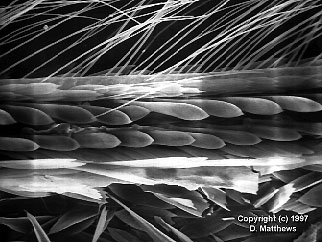
| Plume Moths PTEROPHORIOIDEA | 
| (donherbisonevans@yahoo.com) and Debbie Matthews & Stella Crossley |
|
|
|
|

| Plume Moths PTEROPHORIOIDEA | 
| (donherbisonevans@yahoo.com) and Debbie Matthews & Stella Crossley |
|
|
|
|
The PTEROPHORIDAE, commonly known as Plume Moths, are a well known and easily recognized family. The world fauna is composed of nearly a thousand species in 92 genera. Most species have the wings divided into narrow lobes that resemble feathers or "plumes" because of the long fringe scales along the lobe margins.

The forewing is usually divided into 2 lobes (3 or 4 in a few), the hindwing into 3. Two genera, Agdistis and Ochyrotica have entire wings. Most adults rest with the wings folded or rolled, held perpendicular to the slender body in the characteristic "T"-shaped position. A few rest with the wings tilted back or slightly back and upward in more of a "Y".
The family ALUCITIDAE (Many-Plumed Moths) is often associated with the PTEROPHORIDAE in monographs and popular literature but is easy to distinguish because of the extra lobes of the hindwing and because these moths hold the wings unfolded and flattened against the resting surface.
The PTEROPHORIDAE are distinct from other families in ALCITOIDEA (eg: ALUCITIDAE , and TINEODIDAE ) and PTEROPHORIOIDEA (eg: MACROPIRATIDAE ) in having rows of stout, sclerotized scales on the undersurface of the hindwing along veins Cu2 and M3. These scales have been termed "venous scales" (Gielis 1993).
Caterpillars that feed externally tend to have long primary hairs (setae) and either numerous short, scattered, secondary setae, or longer secondary setae radiating from tubercles. In some genera the primary setae are morphologically distinct and central on these tubercles. Setal morphology is often elaborate, a variety of forms occur in the group. These include setae with spiculate margins, setae with blunt, inflated, capitate, spatulate, tined or conspicuously forked tips, or flattened ovate to discoid setae, as well as simple pointed setae. Inflated, or hollow, open-tipped setae often exude a viscous, sticky fluid which accumulates in a droplet at the end of the seta. The chemical properties of this material are unknown but species with this type of setae tend to be associated with hosts with glandular trichomes. The translucent caterpillar skin (larval cuticle) shows the color of ingested plant material, enhancing the cryptic effect of the setae. Opaque longitudinal stripes are present in some species, and some species have a contrasting dorsal stripe.
Caterpillars that feed internally (stem borers) tend to be cream colored, some with reddish longitudinal bands and/or sclerotized pinacula. These internal feeders have shorter primary setae and either lack secondary setae, or have the short to minute scattered type. Granulate patterns may be present on the cuticle, and a few of the stem borers have a caudal peg or paired thorn-like projections which are sclerotized.
Except for the stem borers, larvae tend to be sluggish. The prolegs of most are elongate and peg-like. Crochets are arranged in a uniordinal, mesal penellipse.
The chrysalis (pupa) is usually attached to the host plant. A small pad of silk is spun to which the pupa is anchored by two patches of hooked setae arising from the tenth abdominal segment. Internally feeding species typically lack or have reduced numbers of hooked setae unless they are species which leave the feeding site for pupation. A few species spin thin, open topped cocoons within the feeding site, or web together a shelter of leaves or plant debris in which to pupate.
The pupal setal arrangement and morphology is typically a reduced version of the mature larva. Pupae of external feeders often have long primary setae, some also with secondary setae variously arranged, forming lateral fringes in some. Seta or spine-like tubercles may be present in association with the primary setae. Several genera have paired dorsal tubercles which are especially developed on the third abdominal segment, forming single, or multiple pointed processes or flattened foliaceous appendages. Some pupae are smooth, or ridged, with all setae primary and short. Smooth pupae are common in internal feeders, but also found in certain genera of external feeders.
The 49 named species of PTEROPHORIDAE now occurring in Australia are:
 Buckleria paludum : Marsh Plume Moth
Buckleria paludum : Marsh Plume Moth
 Cosmoclostis aglaodesma
Cosmoclostis aglaodesma
 Cosmoclostis hemiadelpha
Cosmoclostis hemiadelpha
 Deuterocopus socotranus
Deuterocopus socotranus Deuterocopus tengstroemi
Deuterocopus tengstroemi
 Diacrotricha fasciola : Starfruit Flowermoth
Diacrotricha fasciola : Starfruit Flowermoth
 Exelastis phlyctaenias
Exelastis phlyctaenias
 Exelastis pumilio
Exelastis pumilio
 Hexadactilia civilis
Hexadactilia civilis
 Hexadactilia trilobata
Hexadactilia trilobata
 Imbophorus aptalis
Imbophorus aptalis
 Imbophorus leucophasma
Imbophorus leucophasma
 Imbophorus pallidus
Imbophorus pallidus
 Platyptilia celidotus
Platyptilia celidotus
 Platyptilia isodactylus : Ragwort Plume Moth
Platyptilia isodactylus : Ragwort Plume Moth
 Sinpunctiptilia emissalis : Speedwell Pterror
Sinpunctiptilia emissalis : Speedwell Pterror
 Sinpunctiptilia tasmaniae
Sinpunctiptilia tasmaniae
 Sphenarches anisodactylus : Geranium Plume Moth
Sphenarches anisodactylus : Geranium Plume Moth
 Sphenarches zanclistes
Sphenarches zanclistes
 Stenoptilia phaeonephes
Stenoptilia phaeonephes Stenoptilia zophodactylus : Dowdy Plume Moth
Stenoptilia zophodactylus : Dowdy Plume Moth
 Wheelaria spilodactylus : Horehound Plume Moth
Wheelaria spilodactylus : Horehound Plume Moth
 Xyroptila marmarias
Xyroptila marmarias Xyroptila peltastes
Xyroptila peltastesand some undetermined adult Pterophorids
 family |  butterflies |  Lepidoptera |  moths |  family |
(updated 31 May 2014, 9 September 2024)